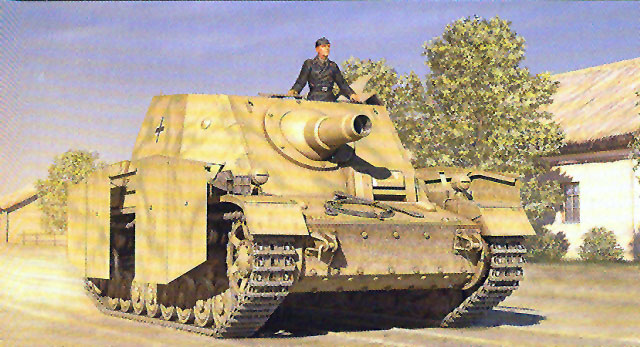
|
Home >
Reviews >
German > Tristar 1/35 scale Kit No. 038; German Sturmpanzer IV (Early) Sd.Kfz. 166 |
Sturmpanzer IV (Early) Sd.Kfz. 166
Reviewed by Cookie Sewell

Summary
| Stock Number and Description |
Tristar 1/35 scale Kit No. 038; German Sturmpanzer IV (Early) Sd.Kfz. 166 |
| Scale: |
1/35 |
| Media and Contents: |
904 parts (838 parts in sand color styrene, 53 etched brass, 10 black styrene, 2 clear styrene, 1 twisted steel cable) |
| Price: |
US $65.00 |
| Review Type: |
FirstLook |
| Advantages: |
New kit from the ground up uses few parts from previous kits; early variant is a different model from other kits; does not require zimmerit coating |
| Disadvantages: |
High price may deter some purchases; use of small parts and precision assembly requirements may frustrate some modelers |
| Recommendation: |
Highly Recommended for all WWII German fans
|
FirstLook
Right after DML released a new kit of the mid-production variant of the Brummbaer assault howitizer, Tristar has released an early production variant of its own. This kit is nearly totally new, using only a few suspension sprues and the tracks from its previous Panzer IV series releases.
According to those “in the know” this kit represents one of the first 60 or so vehicles and as such has no zimmerit coating, a different driver’s viewer and mounting, a different gun protective jacket, no defensive armament and a different roof to the casemate. The kit appears to match those details perfectly. Also included are both “stock” and “worn” springs for the front two bogies, intended to replicate the nose-down overloaded look many Brummbaers took on after some service as the heavy casemate tended to wear out the suspension.
The model provides about the same level of interior detail as the DML kit – basically you get a nicely detailed howitzer and its mount, a floor plate, and a rear bulkhead but little else. This isn’t so bad as the roof hatches are small and there just isn’t much to see through them. Note that while the barrel was slide molded there is no rifling detail provided.
One major item with Tristar kits that I have encountered, and many modelers commented on, is the fact they are not for people in a hurry or sloppy “that’s close” modelers. The models would be the envy of any aircraft modelers going as they require zero putty if assembled absolutely correctly. This requires taking your time and dry-fitting many parts to see if they need trimming or sanding. It’s not a problem with the kits; all plastic parts require a slight bevel to their edges or they cannot be pulled from a mold no matter how many ejection pins are used, and in order to minimize this a slight bevel and oversize molding are used. Once the parts are properly prepared (and you follow the assembly sequence) the results can be amazing.
The suspension is very detailed and each bogie assembly involves 14 parts, with one being the option between “new” and “clapped out” springs. Armor covers are provided for the final drives and a wealth of detail is provided for the rear plate. The main hull pan is one piece less said rear plate, and appears to have been slide molded with a goodly number of details. At least 14 parts are required to detail the lower stern plate. Front armor components are applique ones to ensure good crisp bold and rivet details. Note that these are not like DML “Smart Kits” as the etched brass is integral to assembly and must be used.
Construction is pretty straightforward with the lower hull, fenders, engine deck and tracks all going in order. Tristar’s tracks are “snap together” but the pins tend to be a bit weak, so plan on cementing them in place once completed and installed for strength. Also note there are right and left links, and Tristar does differentiate between them on the sprues. The 36 on the left of each sprue (“L”) are left hand and the 36 on the right (“R”) are right hand, so don’t simply nip them off the sprues first.
The gun assembly is fairly involved with 37 parts to the complete assembly and another 6 for the mount. The periscopic sight (H-2) is clear, which is an nice idea but somewhat difficult to paint and install in practice with other kits.
Unlike the DML kit which slide molded the entire casemate, Tristar uses a frame and seven separate panels with interlocking mortises per the original for assembly. (This idea alone suggests a complete “MIG” style build with the casemate blown to bits in a diorama, but I digress.) The only internal details here are the driver’s visor and its controls, and nothing else is provided. All hatches are separate, but it will be up to the after-market boys to come up with “filling” for this beast.
The side skirts for this kit are provided as sections of thin black styrene pre-cut and pre-punched for mounting. VP1 are the right side and VP2 are the left side, and while it appears you could reverse them given the strict tolerances of Tristar kits that may not work out too well. Note that there are no hangers like those used in other kits; I am not knowledgeable enough of German skirting to say if that is correct or not.
Technical input for this kit was provided by Yosikatsu Tomioka and Tom Jentz.
Three finishing options are offered: all for Sturmpanzer Abteilung 216, Kursk 1943; vehicle 30 in green over sand mottle, vehicle 28 in green patches over sand, and vehicle 55 in sand only.
Overall this is a nice kit and has the added benefit of not needing zimmerit paste; but it is priced about 30% more than its competitors and that could unfortunately put off some modelers.
Highly Recommended.
Thanks to
Bob Lewen of MRC for the review sample
|